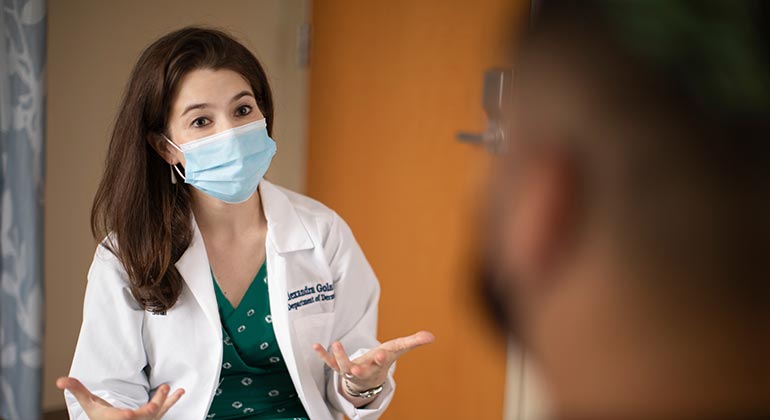Rashes

Sometimes your skin becomes red or has raised spots. Often, this happens because of an allergy or illness. There are many types of rashes. At Mount Sinai, we treat the most complicated of rashes. We are experienced in treating skin manifestations of lupus, lichen planus, pyoderma gangrenosum, leg ulcers, infectious diseases like methicillin-resistant staph infection (MRSA), and many others.
The types of rashes we see most often are:
- Heat rash (or prickly heat) develops in hot weather. When your pores, or sweat ducts, block perspiration under your skin, you can get a rash. The rash can look like gritty, clear bumps or deep, red bumps. You are likely to get heat rash in your skin folds and where your clothing is particularly tight. Infants usually get heat rash on the neck, shoulders, and chest. Usually, it goes away when your skin cools down. However, if you or your child has symptoms that last more than a few days, it is time to see a doctor.
- Poison ivy is an allergic reaction to the oils in poison ivy, poison oak, and poison sumac. It is caused by urushiol, an oily residue in the leaves, stems, and roots of these plants. If you come into contact with one of these plants, wash your skin right away to decrease the chances of getting a rash. You can treat mild poison ivy rashes with lotions and cool baths. If the rash is severe or widespread (or on your face or genitals), then you may need a prescription medication.
- Diaper rash is inflamed skin on your baby’s bottom. Often, it comes from diapers that are wet or are not changed quickly enough. You can tell your baby has diaper rash by the red, tender-looking skin in the diaper area. Your baby may also seem more irritable in general, and during diaper changes in particular. Diaper rash usually responds to zinc oxide ointment. If this does not work and the rash does not go away, or if it gets worse, you might need to take your baby to the doctor.
- Contact dermatitis occurs when you come into contact with certain chemicals or substances. Different people react to different substances; some people might get a rash from an acidic chemical, some from a fragrance. We use your medical history and patch testing to figure out what is causing this rash and provide treatment.
When to See a Doctor
Most rashes are not life threatening. Often, you can treat them with over-the-counter hydrocortisone cream or antihistamines. However, sometimes you really do need to see a doctor. If you have any of these symptoms, you should seek professional help:
- The rash is all over your body.
- You are also running a fever.
- Your rash appeared suddenly and is spreading quickly.
- The rash is blistering or painful.
- Your rash is infected and is turning yellow or green.
- If the rash has been bothering you for a long time and affecting your quality of life.